Fuji X-E4 vs X-T200 vs X-S10 vs X-T30
Let's put aside the recent X-T4, the X-T3 and other big and heavy models to focus on the lighter ones since the era uses us to compact devices such as smartphones...
Why choose a Fuji?
The main reason to opt for a Fuji is the excellent 18-55 lens with its large aperture and very good sharpness. These camera also have some other advantages.
- Startup in 0.4 seconds, compared to Sony, it's instant.
- For those who only produce JPEGs, quality images right out of the camera.
- Film simulations, to reproduce special atmospheres.
- Sensor cleaning by Ultra Sonic Vibration process.
- Using the joystick, moving the focus area is very easy.
- The camera can be recharged with a USB cable.
- Convert RAW to JPEG in the camera, remove red-eye, etc.
And why not choose a Fuji...
- Despite specifications like 4K video without cropping, Fuji does not excel in video except for the new X-S10.
- The menu is a labyrinth. Only the button assignment panel is very well designed, but this is the least used.
- The quick menu would be a good idea but its implementation for custom modes on X-T30 beyond the convoluted makes it an ergonomic nightmare.
- No C1, C2 buttons. The X-T200 has no custom mode at all.
- The retro look can seem old-fashioned, as well as certain features like the grain effect which have no reason to exist in our time.
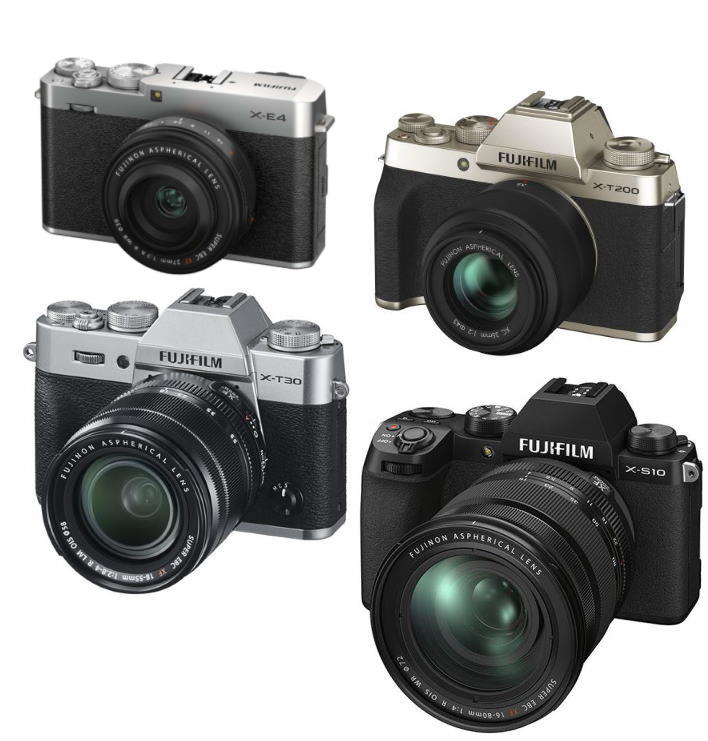
But which model to choose?
Comparison
| X-E4 | X-T200 | X-S10 | X-T30 | |
|---|---|---|---|---|
| Sensor | APS-C | APS-C | APS-C | APS-C |
| Pixels (million) | 26 | 24 | 26 | 26 |
| Resolution in 3:2 | 6240x4160 | 6000x4000 | 6240x4160 | 6240x4160 |
| Kit lense | 27mm F/2.8 | 15-45mm f/3.5-5.6 | 18-55mm f/2.8-4 | 18-55mm f/2.8-4 or 15-45mm f/3.5-5.6 |
| Sensitivity | ISO 160-12800 | ISO 200-12800 | ISO 160-12800 | ISO 160-12800 |
| Focus points | 425 | 425 | 425 | 425 |
| Autofocus modes | Single - Tracking / Contrast and phase detection / Face / Eye | Single - Tracking / Contrast and phase detection | Single - Tracking / Contrast and phase detection / Face / Eye | Single - Tracking / Contrast and phase detection |
| Shutter speeds | 15mn - 1/4000s Electronical 1/32000s |
30s - 1/4000s Electronical 1/32000s |
30s - 1/4000s Electronical 30s - 1/32000s |
15mn - 1/4000s Electronical 1/32000s |
| Burst | 30 ips | 8 fps | 30 fps | 30 fps |
| Digital Zoom | - | yes | - | - |
| Pre-shot | 10 images | - | 10 images | 14 images |
| Format of pictures | RAW, JPEG | RAW, JPEG | RAW (Auto also) , JPEG | RAW, JPEG |
| Format of videos | MPEG-4 AVC / H.264 | MPEG 4 / AVC H.264 | MPEG 4 / AVC H.264 | MPEG 4 / AVC H.264 |
| Panorama | yes | yes | yes | yes |
| IBIS | - | - | yes | - |
| HDR | yes | yes | yes | yes |
| AE Bracketing | yes | yes | yes | yes |
| Focus Bracketing | - | - | yes | yes |
| WB Bracketing | yes | yes | yes | yes |
| Film Sim. Bracketing | yes | yes | yes | yes |
| ISO Bracketing | yes | yes | yes | yes |
| Multiple exposures | yes | yes | yes | yes |
| Starting time | 0.4s | 0.4s | 0.4s | 0.4s |
| Distortion correction | yes | yes | yes | yes |
| Timelapse | yes | yes | yes | yes |
| Video | 4K 30p 24p - FHD 240p | 4K 30p 24p - FHD 60p | 4K 30p 24p - FHD 240p (3mn) | 4K 30p 24p - FHD 120p |
| Video stabilization | Software | Virtual gimbal in FHD | IBIS + Digital | Software |
| Video duration | 30mn 4K and FHD | 15mn 4K - 30mn FHD | 30mn 4K and FHD | 10mn 4K - 15mn/6mn FHD |
| Microphone jack | 3.5mm | 3.5mm | 3.5mm | 2.5mm |
| Autonomy | 360 still images | 270 still images | 325 still images | 380 still images |
| USB charging | yes | yes | yes | yes |
| Connections | HDMI - USB 3.2 Type C | HDMI - USB 3.1 Type C | HDMI - USB 3.2 Type C | HDMI, USB 3.0 Type C |
| Bluetooth | 4.2 | 4.2 | 4.2 | 4.2 |
| Wi-Fi | 802.11b/g/n | 802.11b/g/n | 802.11b/g/n | 802.11b/g/n |
| Integrated flash | - | 7 meters | yes | 5 meters |
| Viewfinder | OLED 2360 K 0.62x | OLED 2360 K 0.62x | OLED 2360 K 0.62x | OLED 2.360 K |
| Touch screen | Focus / Swipe / Q Menu | Full | Focus / Swipe / Q Menu | Focus and other functions |
| Movable screen | Tilt | Articulated | Articulated | Tilt |
| Remote control | 3.5mm | By Wifi / By USB | 3.5mm | By Wifi / By USB |
| Edition in device | yes | yes | yes | yes |
| Storage | SD, SDXC UHS-1 | SD, SDXC UHS-1 | SD, SDXC UHS-1 | SD, SDXC UHS-1 |
| Weather sealing | - | - | - | - |
| Size | 121.3 x 72.9 x 32.7 mm | 121 x 83.7 x 55.1 mm | 126 x 85.1 x 65.4 mm | 118 x 83x 47 mm |
| Body weight | 364g | 370g | 465g | 383g |
| Year | 2020 | 2020 | 2020 | 2019 |
Reasons to choose the X-E4
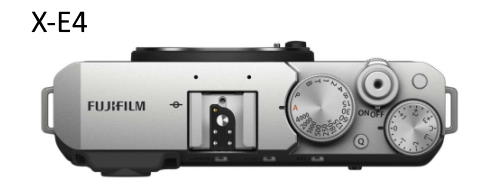
- It is the most compact of the three.
- 7 custom settings. The X-T200 does not have one.
- If you prefer a fixed focal length, but with better image quality. You can then add a zoom.
- When you don't often make videos.
Reasons to choose the X-T200
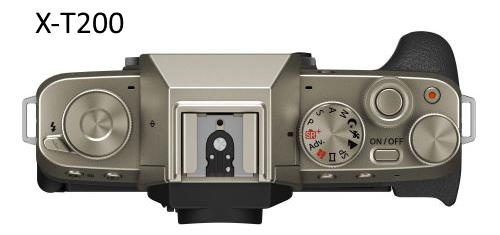
- Classic mode dial for those who are used to it.
- Improved, simpler user interface.
- A full touch screen, which apply to all menus and not only the quick menu.
- Digital zoom that works with the touch screen, like on a smartphone.
- HDR video mode for an augmented dynamic range (in Full HD).
- The virtual gimbal takes advantage of a gyroscope to improve video stabilization. But work only in Full HD and with some lenses.
- Button to start a video.
- Modernized menus. You are no longer offered to add grain or clone dead pixels!
- Videos can last longer.
- Editing functions built into the device: RAW to JPEG, red-eye removal, etc.
- USB 3 type C connector.
Reasons to choose the X-S10
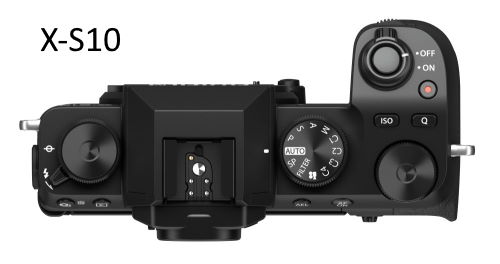
- It is almost equivalent to the X-T4 with the same 26MP sensor, in a more compact format similar to the X-T200.
- A mode dial familiar to users of other brands.
- This camera is designed especially for video, but retaining the photo capabilities of the brand.
- It has a video button and a duration in 4k of 30 minutes.
- Stabilization in the body eases video and night shooting.
- Focus bracketing and pre-shot like the X-T30.
- For the first time, custom mode options, C1 to C4, appear on the dial.
- The only one of the four that saves all the options chosen in the current custom mode and only in this mode. (The X-T200 does not have custom modes at all).
- You can make RAW images in auto mode.
- 18 film simulations like on the X-T4. With a dial to select a simulation.
- A large grip for long sessions.
- USB 3 type C connector.
Reasons to choose the X-T30
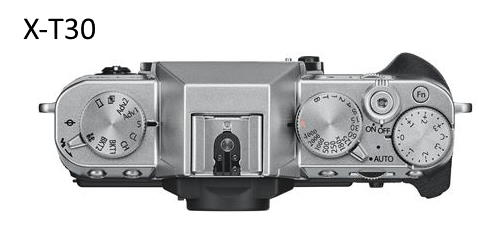
- Numerous dials and control buttons.
- Modern 26 MP Sony sensor (IMX571) that the latter does not yet use in its own models!
- The pre-shot function allows you to keep continuous images as long as the shutter is half pressed, and when you press the shutter, the 14 shots previously kept in memory are stored in files too.
- Focus bracketing takes pictures with the focus on different subjects, so that you can combine them into a single image (with software).
- Record a voice memo with the snapshot, saved in a WAV file.
- Editing functions built into the device: RAW to JPEG, red-eye removal, etc. USB 3 type C connector.
- A button to choose between manual, single or continuous focus.
Updated July 14, 2021: Replaced X-E3 by X-E4.
See also ...
- Canon EOS M50 and M6 II vs Sony A6400 and A6500 vs Fujifilm X-T30
Extend the choice with other brands. - Best Micro 4/3 cameras
Or choose a more portable format (taking into account the lenses).
Documents...






